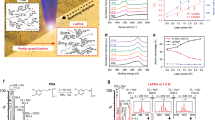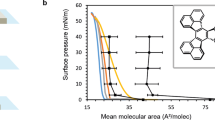Abstract
Polyaniline nanofibres can be prepared by a number of methods based on chemical oxidative polymerization1,2,3,4,5,6,7 and in situ adsorption polymerization4,5,6. However, the lack of alignment in these nanostructures makes them unsuitable for many applications. Here, we report a simple approach to chemical oxidative polymerization that can control the growth and simultaneous alignment of polyaniline nanofibres grown on a range of conducting and non-conducting substrates in a wide variety of sizes. The diameters of the tips of the nanofibres can be controlled within the range 10–40 nm, and the average length can be controlled within the range 70–360 nm. Moreover, the coatings display a range of properties including superhydrophilicity and superhydrophobicity. Such nanostructured coatings may be useful for applications such as anti-fog coatings, self-cleaning surfaces, DNA manipulation, transparent electrodes for low-voltage electronics, and chemical and biological sensors.
This is a preview of subscription content, access via your institution
Access options
Subscribe to this journal
Receive 12 print issues and online access
$259.00 per year
only $21.58 per issue
Buy this article
- Purchase on Springer Link
- Instant access to full article PDF
Prices may be subject to local taxes which are calculated during checkout



Similar content being viewed by others
References
Martin, C.R. Nanomaterials: A membrane-based synthetic approach. Science 266, 1961–1966 (1994).
Wu, C.-G. & Bein T. Conducting polyaniline filaments in a mesoporous channel host. Science 264, 1757–1759 (1994).
Wei, Z., Zhang Z. & Wan M. Formation mechanism of self-assembled polyaniline micro/nanotubes. Langmuir 18, 917–921 (2002).
Huang, J., Virji, S., Weiller, B. H. & Kaner, R. B. Polyaniline nanofibers: Facile synthesis and chemical sensors. J. Am. Chem. Soc. 125, 314–315 (2003).
Sawall, D. D., Villahermosa, R. M., Lipeles, R. A. & Hopkins, A. R. Interfacial polymerization of polyaniline nanofibers grafted to Au surfaces. Chem. Mater. 16, 1606–1608 (2004).
Zhang, X., Goux, W. J. & Manohar, S. K. Synthesis of polyaniline nanofibres by nanofiber seeding. J. Am. Chem. Soc. 126, 4502–4503 (2004).
Zhang, X., Kolla, H. S., Wang, X., Raja, K. & Manohar, S. K. Fibrillar growth in polyaniline. Adv. Funct. Mater. 16, 1145–1152 (2006).
MacDiarmid, A. G. & Epstein, A. J. Polyanilines: a novel class of conducting polymers. Faraday Discuss. Chem. Soc. 88, 317–332 (1989).
Avlyanov, J. K., Josefowicz, J. Y. & MacDiarmid, A. G. Atomic force microscopy surface morphology studies of ‘in situ’ deposited polyaniline thin films. Synth. Met. 73, 205–208 (1995).
Stejskal, J., Sapurina, I., Prokes, J. & Zemek, J. In-situ polymerized polyzaniline films. Synth. Met. 105, 195–202 (1999).
Liang, L., Liu, J., Windisch, C. F., Exarhos, G. J. & Lin, Y. Direct assembly of large arrays of oriented conducting polymer nanowires. Angew. Chem. Int. Edn 41, 3665–3668 (2002).
Liu, J. et al. Templateless assembly of molecularly aligned conductive polymer nanowires: A new approach for oriented nanostructures. Chem. Eur. J. 9, 604–611 (2003).
Chiou, N.-R. & Epstein, A. J. Polyaniline nanofibers prepared by dilute polymerization. Adv. Mater. 17, 1679–1683 (2005).
Chiou, N.-R. & Epstein, A. J. A simple approach to control the growth of polyaniline nanofibers. Synth. Met. 153, 69–72 (2005).
MacDiarmid, A. G. & Epstein, A. J. The concept of secondary doping as applied to polyaniline. Synth. Met. 65, 103–116 (1994).
Yue, J. & Epstein, A. J. Synthesis of self-doped conductive polyaniline. J. Am. Chem. Soc. 112, 2800–2801 (1990).
Han, C.-C. & Jeng, R.-C. Concurrent reduction and modification of polyaniline emeraldine base with pyrrolidine and other nucleophiles. Chem. Commun. 553–554 (1997).
Salavagione, H., Morales, G. M., Miras, M. C. & Barbero, C. Synthesis of a self-doped polyaniline by nucleophilic addition. Acta Polym. 50, 40–44 (1999).
Huang, W. S., Humphrey, B. D. & MacDiarmid, A. G. Polyaniline, a novel conducting polymer. J. Chem. Soc., Faraday Trans I. 82, 2385–2400 (1986).
Tzou, K. & Gregory, R. V. Kinetic study of the chemical polymerization of aniline in aqueous solutions. Synth. Met. 47, 267–277 (1992).
Bunker, B. C. et al. Ceramic thin-film formation on functionalized interfaces through biomimetic processing. Science 264, 48–55 (1994).
Nakao, H. et al. Development of novel polymer-coated substrates for straightening and fixing DNA. Nano Lett. 2, 475–479 (2002).
Acknowledgements
The present work was supported in part by the National Science Foundation under NSF Grant No. EEC-0425626.
Author information
Authors and Affiliations
Contributions
N.-R.C. and A.J.E. were responsible for the fabrication, coatings and characterization of aligned nanofibres and related analyses. The superhydrophilicity, superhydrophobicity and microfabrication were studied by C.L., N.-R.C. and L.J.L. DNA stretching was studied by J.G., N.-R.C. and L.J.L. N.-R.C. and A.J.E. co-wrote the paper.
Corresponding author
Ethics declarations
Competing interests
The authors declare no competing financial interests.
Supplementary information
Supplementary Information
Supplementary figures S1–S5 (PDF 1810 kb)
Supplementary Information
Supplementary movie (AVI 3247 kb)
Rights and permissions
About this article
Cite this article
Chiou, NR., Lu, C., Guan, J. et al. Growth and alignment of polyaniline nanofibres with superhydrophobic, superhydrophilic and other properties. Nature Nanotech 2, 354–357 (2007). https://doi.org/10.1038/nnano.2007.147
Received:
Accepted:
Published:
Issue Date:
DOI: https://doi.org/10.1038/nnano.2007.147
This article is cited by
-
Complementary multicolor electrochromic devices with excellent stability based on porous tin oxide nanosheet scaffold
Nano Research (2024)
-
Improvements in the biochemical responses and Pb and Ni phytoremediation of lavender (Lavandula angustifolia L.) plants through Funneliformis mosseae inoculation
BMC Plant Biology (2023)
-
Shielded goethite catalyst that enables fast water dissociation in bipolar membranes
Nature Communications (2021)
-
Probing the electrical and dielectric properties of polyaniline multi-walled carbon nanotubes nanocomposites doped in different protonic acids
Polymer Bulletin (2021)
-
3D Hierarchical Carbon-Rich Micro-/Nanomaterials for Energy Storage and Catalysis
Electrochemical Energy Reviews (2021)



